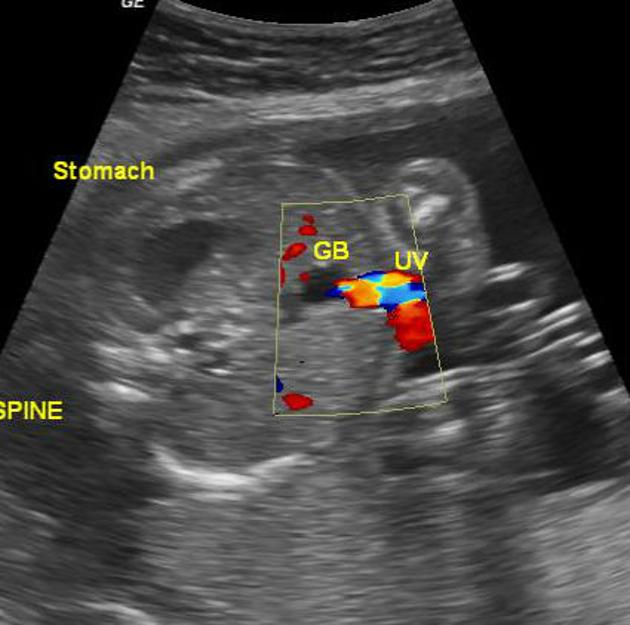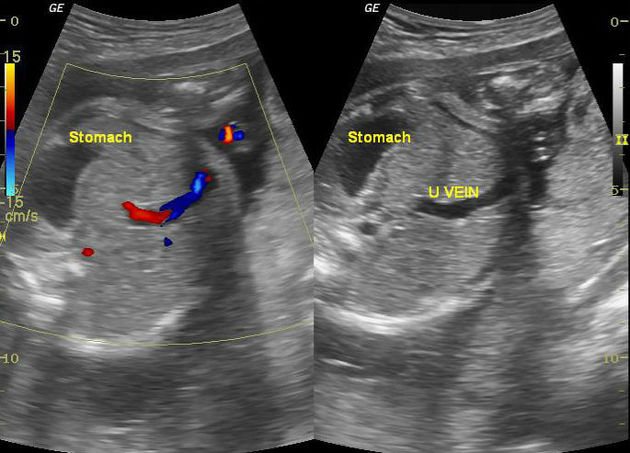Citation, DOI, disclosures and article data
Citation:
Weerakkody Y, Campos A, Hacking C, et al. Persistent right umbilical vein. Reference article, Radiopaedia.org (Accessed on 09 Mar 2025) https://doi.org/10.53347/rID-13564
A persistent right umbilical vein (PRUV) is an uncommon vascular anomaly which is often detected in utero.
The estimated prevalence is ~2 per 1000 births 1,2.
In the normal situation, the right umbilical vein begins to obliterate in the ~4th week of gestation and disappears by the 7th week. With a PRUV, the right umbilical vein remains open and the left umbilical vein usually obliterates. A PRUV may also be supernumerary 6.
Location
A PRUV can be intra- or extrahepatic. The former is much commoner.
Associations
Numerous associations have been described (albeit at relatively low rates 3,9). They are commoner with the extrahepatic type and include:
Ultrasound
It is usually detected in the 2nd to 3rd trimester. Assessment is usually made in the axial plane and color Doppler is often required. An intrahepatic persistent right umbilical vein may be seen as an umbilical vein abnormally connected to the right portal vein and the fetal gallbladder is positioned medial to the PRUV.
Treatment and prognosis
When additional anomalies are ruled out, a PRUV in isolation carries a generally favorable outcome 1,9.
If a persistent right umbilical vein is detected, a careful sonographic anatomical survey is generally recommended to rule out more serious congenital malformations 10.
Related articles
-
1. Wolman I, Gull I, Fait G et al. Persistent Right Umbilical Vein: Incidence and Significance. Ultrasound Obstet Gynecol. 2002;19(6):562-4. doi:10.1046/j.1469-0705.2002.00678.x - Pubmed
-
2. Beryl R. Benacerraf. Ultrasound of Fetal Syndromes. (2008) ISBN: 9780443066412 - Google Books
-
3. Nakstad B, Smevik B. Abnormal systemic venous connection possibly associated with a persistent right umbilical vein; a case report. BMC Pediatr. 2004;4 : 7. doi:10.1186/1471-2431-4-7 - Free text at pubmed - Pubmed citation
-
4. Kirsch C, Feldstein V, Goldstein R, Filly R. Persistent Intrahepatic Right Umbilical Vein: A Prenatal Sonographic Series Without Significant Anomalies. J Ultrasound Med. 1996;15(5):371-4. doi:10.7863/jum.1996.15.5.371 - Pubmed
-
5. Shen O, Tadmor O, Yagel S. Prenatal Diagnosis of Persistent Right Umbilical Vein. Ultrasound Obstet Gynecol. 1996;8(1):31-3. doi:10.1046/j.1469-0705.1996.08010031.x - Pubmed
-
6. Jeanty P. Persistent Right Umbilical Vein: An Ominous Prenatal Finding? Radiology. 1990;177(3):735-8. doi:10.1148/radiology.177.3.2243979 - Pubmed
-
7. Ricklan DE, Collett TA, Lyness SK. Umbilical vein variations: review of the literature and a case report of a persistent right umbilical vein. Teratology. 1988;37 (2): 95-100. doi:10.1002/tera.1420370202 - Pubmed citation
-
8. Bradley E, Kean L, Twining P et-al. Persistent right umbilical vein in a fetus with Noonan's syndrome: a case report. Ultrasound Obstet Gynecol. 2001;17 (1): 76-8. doi:10.1046/j.1469-0705.2001.00243.x - Pubmed citation
-
9. Blazer S, Zimmer EZ, Bronshtein M. Persistent intrahepatic right umbilical vein in the fetus: a benign anatomic variant. Obstet Gynecol. 2000;95 (3): 433-6. - Pubmed citation
-
10. Hill L, Mills A, Peterson C, Boyles D. Persistent Right Umbilical Vein: Sonographic Detection and Subsequent Neonatal Outcome. Obstet Gynecol. 1994;84(6):923-5. - Pubmed
-
11. Eberhard Merz. Ultrasound in Obstetrics and Gynecology. (2005) ISBN: 9781588901477 - Google Books
Promoted articles (advertising)

